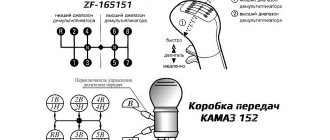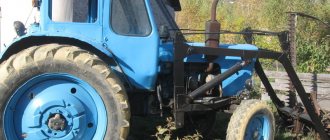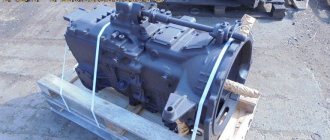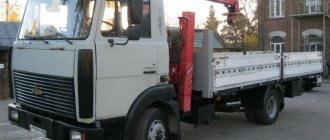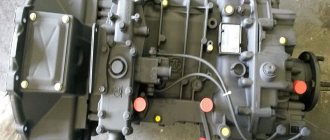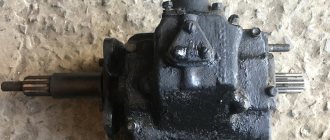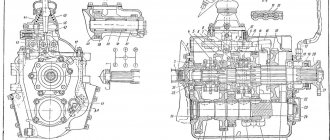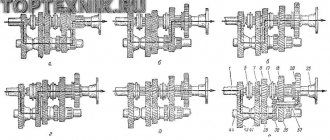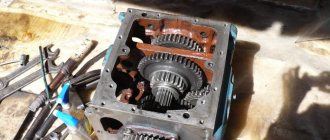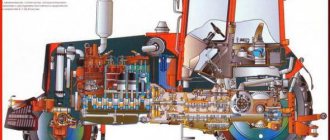03/03/2022 20,788 Transmission
Author: Victor
In any car, the gearbox is one of the main units. And if we are talking about KamAZ, then it is also a complex device. This material will help you understand the design features, as well as how to change gears on a KamAZ and what not to do.
[Hide]
Design and principle of operation
Let's consider the location and design of the KamAZ vehicle gearbox. KamAZ trucks are equipped with manual transmissions. They have 5 speeds. The gearbox is switched by pressing the clutch pedals and moving the gearshift lever to the desired position. Since the car is heavy, it is necessary to transfer the gearbox from one gear to another in several stages.
The principle of operation of the KamAZ gearbox is as follows: with a diesel engine it works either in high mode B or in low mode H. They were created to reduce the load on the engine of a heavy vehicle when it is full, and at the same time not force it to work too actively without load.
The design of a KamAZ gearbox with a divider is simple, but it differs depending on the model of the gearbox. Let's look at the KamAZ gearbox diagram, which is found on diesel vehicles. When driving on a flat road, you need to change gears without a clutch. The design of the KamAZ transfer case can be represented by the following formula: 1B - 2B - 3B - 4H - 4B - 5H - 5B.
Switching speeds is carried out as follows:
- First, switch the gearbox operating mode from high to low using a lever.
- Then release the clutch.
- The lever is set to the desired gear, without jumping over them, but turning everything on in order.
There are gearboxes with automatic mode switching.
How does the divider work on KamAZ?
The gearbox divider or multiplier is an additionally installed overdrive, which converts a 5-speed gearbox into a 10-speed gearbox.
The principle of its operation is as follows. The multiplier reduces the ranges between the main gears, tightening the number of gear ratios of the box and expanding them by 20-25 percent.
This modification allows you to improve such vehicle characteristics as:
- fuel efficiency;
- acceleration speed;
- traction force;
- controllability.
The mechanism is located in front of the gearbox, or slightly to the right of it, since the main unit does not experience heavy loads and does not require structural modifications. This allows you to repair and adjust the divider yourself if a malfunction occurs.
Location and order of gear shifting on KamAZ
Most cars from the Kama plant are equipped with manual gearboxes with 5 steps (with or without a divider). Gear shifting is carried out by moving the gearbox rocker with the clutch pedal pressed. But gears on trucks should not be engaged directly, but in stages. Theoretically, this reduces the load on the engine when driving with a full load, and when working with an empty body, it saves fuel.
The usual operating modes of the KamAZ gearbox are increased “B” or decreased “H”. In cars equipped with a gearbox with a multiplier, switching from mode “B” to mode “H” is carried out by lowering a special single divider lever.
It is important to know how to engage a higher gear when driving a KamAZ with a full load: experienced drivers recommend engaging the first 4 gears in the heavy secondary “H” mode, and then transferring the 4th speed to the “B” mode, switching to the 5th lower gear, and then go to “B”. The shift order may vary depending on the specific gearbox model.
What you need to know about the transmission
The machine transmission consists of the following parts and components:
- power point;
- gear box;
- block for engaging reverse gear;
- three-shaft crankcase;
- unit protective cover.
The type and design of the gearbox directly depends on the truck model. At the moment, most cars are equipped with a five-speed manual transmission. The transmission can have a gearbox with 10 gears. 5-speed gearboxes are mainly used on KamAZ trucks, which are operated as individual trucks. 10-speed ones are relevant for huge road trains transporting impressive loads.
KamAZ models on which these two types of boxes are installed:
- 55111;
- 43118;
- 4308;
- 5490;
- 5511;
- 53229;
- 53212;
- 53205;
- 53114;
- 65115 and many others.
The ten-speed gearbox has increased power. It was developed specifically for vehicles that are operated in difficult conditions, for example, on unsuitable ground for driving, mountainous terrain, and transporting large and massive loads.
The main design feature of this box is the appearance of a gearbox that allows operation in two modes, specifically low and high. It has an improved synchronizer. The power of the transmission has increased significantly due to the mode divider. It is necessary to reduce the load on the engine, which has a positive effect on its performance and efficiency.
When driving in light mode, the divider lever must be in the lowered position. If you intend to drive with a load, it must be placed in a raised state.
Regardless of the type of gear engaged - both low and high speed, the use of the clutch system is mandatory. The driver operates it using the appropriate pedal in the cabin.
Specifications
The KamAZ gearbox with a divider includes the following elements:
- a crankcase in which the drive, driven and intermediate shafts assembled with gears are mounted;
- bearings;
- synchronizers,
- reverse gear block,
- top cover of the box,
- gear shift mechanism.
The gearbox of KamAZ vehicles can be five- or ten-speed. The gearbox divider has high and low gears and, in combination with the main gearbox, allows for 10 forward gears and 2 reverse gears. The divider system improves the traction qualities of the machine, makes it easier to control, and reduces the frequency of shifting gears with a lever. Transmission ratios are available in the operating instructions for the device.
The 141 KamAZ gearbox has a reversing light switch. To prevent the simultaneous activation of 2 gears, there is a ball-type lock in the cover, and a spring-finger fuse is used to prevent accidental engagement of reverse gear. The gearbox with divider weighs 320 kg. The cuffs are located in the shaft covers. They protect the gearbox from clogging and prevent oil leakage. Insufficient oil volume in the gearbox leads to its damage. When you first fill the gearbox there should be 9 liters of oil, when changing the fluid - 8 liters.
Technical characteristics of the KamAZ-141 gearbox: Carter:
- The diameter of the bearing bore is 150 mm.
- The diameter of the hole in the gear block axis is 32 mm.
Main shaft:
- The diameter of the front bearing journal is 24 mm.
- Rear bearing - 59 mm.
The secondary shaft has the following diameters for the parts:
- Fourth gear gear bushings - 63 mm.
- Roller bearings - 80 mm.
- Reverse gear bushings - 70 mm.
- The outer diameter of the sleeve is 72 mm.
Intermediate shaft:
- The diameter of the front bearing journal is 65 mm, the rear one is 49 mm.
- The diameter of the rear bearing cup is 119 mm.
- The diameter of the intermediate shaft is 65 mm.
- The inner diameter of the gear is 65 mm.
The weight of the gearbox with divider is 320 kg.
Instructions
Now we suggest you find out how to start and in what sequence to correctly engage the gears on a KAMAZ gearbox. There are certain features in this process, and the procedure for changing gears differs from passenger cars.
Start of movement
You need to know how to change gears on a KamAZ. The KamAZ truck should start moving at a reduced speed. Please note that when driving away, the gear shift is carried out with the clutch disengaged. In KAMAZ gearboxes, the switching scheme is carried out in several stages, this is due to the peculiarities of increasing and decreasing speeds.
How to turn on the speeds on KamAZ:
- The truck can drive quickly on different types of roads, but at the first stage, in accordance with the diagram, it is recommended to start driving in gear 1B.
- After this, 2V transmission is switched on.
- At the final stage of starting from a standstill, speed 3B is switched on.
In accordance with this traffic pattern, the vehicle starts at a reduced speed. That is, the shift lever on the box does not need to be touched until fourth gear. To start moving, you need to increase the crankshaft speed to about seven thousand revolutions
Switching speeds
Now we’ll tell you how the gearbox on a KamAZ is switched when the car starts moving. When the car accelerates, the gear shift order on KamAZ is as follows - 4N-4V-5N. To activate the second speed, the crankshaft speed must increase to three thousand revolutions according to the tachometer. Please note that the operation of the crankshaft plays a major role. By changing gears correctly, you can achieve savings in fuel consumption. In this case, the most economical operation of the motor without downtime will be achieved.
Reverse
As for reverse, according to the diagram, to activate it, you need to set the switch to the lower left position. Activating reverse gear is not allowed while driving. To engage reverse, stop the vehicle completely and then perform the maneuver.
How to change gears on KamAZ
To change gears correctly, you need to know how the transmission works. The gearbox is designed in such a way that movement is often carried out at a reduced speed, so the machine can transport heavy loads. KamAZ has a 5-speed gearbox. You need to change gears using the clutch pedal and lever.
Start of movement
Before you start moving, you must press the reduced speed. Shift gears only with the clutch pedal depressed. The gear shift pattern is based on staged gear shifting. To start driving a truck, you need to spin the crankshaft of the internal combustion engine.
The second gear must be engaged when the needle on the tachometer reaches mark 3, which means 3000 rpm. This method of gear shifting will make it possible to extend the life of the gearbox and reduce gasoline consumption.
Switching speeds
Let's consider the procedure for switching gears after the car has already started moving. When KamAZ accelerates, the gear shift order is: 4H - 4B - 5H. To engage speed 2, the crankshaft speed must increase to 3000 rpm according to the tachometer readings. The functions of the crankshaft are basic.
Reverse
To engage reverse on a truck, you need to place the switch in the lower left position. Reverse gear cannot be engaged while the vehicle is moving. To engage reverse, you must first completely stop the unit, then perform a maneuver.
Box divider
High and low operating modes, a feature of KamAZ gearboxes. This specificity is caused by the desire to reduce the load on the power plant. It is typical that it does not matter whether the machine is loaded or not. A divider is a gearbox based on the principle of mechanics and increases gear ratios. The mechanism is started using a switch on the rocker.
The design includes:
KamAZ-15 box divider input shaft:
- The valve that controls the device. The part is attached to the base of the switch, uses direct and reduced speed modes.
- A valve that maintains a constant outlet pressure. It takes compressed air and resets the pressure in the system when the established values are exceeded. Transfers air to the control valve and to the valve of the dividing device from the air unit. Thanks to manipulations, there are simultaneously two circuits in the engine control system.
- Divider activation valve. Supplies air pressure to the device when the clutch is disconnected. This engages and disengages low gear, paralleling the transmission's gear changes.
- Dividing mechanism. The composition includes a piston placed inside a cylinder. The piston lever is connected to a rod fixed to the fork shaft of the assembly. When air pressure hits, the piston moves, this changes the operating mode of the box.
- The air distribution pipe supplies air pressure to the cylinder of the unit.
Switching rules under different conditions
Gear changes depend on the various conditions in which the vehicle is moving. These rules should be followed so that during the use of the gearbox it does not fail.
Climb
During an ascent, you must switch the gearbox to mode H, as a result of which the transmission will begin to operate at increased voltage.
The following rules must be followed:
- When switching from 1st to 2nd gear when ascending a KamAZ truck, you must use the method of depressing the clutch pedal twice.
- In order for the crankshaft to work correctly when changing gears, you need to use the fuel pedal; it also needs to be pressed periodically. At the same time, you can overcome any steepest climb.
- The shaft speed when lifting must be more than 2000 rpm. Otherwise, the engine may shut down, which may cause an accident while driving on the road.
- During the climb, switch to the desired mode, this will facilitate the operation of the engine and all components of the machine.
Descent
Some drivers turn off the engine when descending a mountain to save gas. This should not be allowed at KamAZ.
If you turn off the internal combustion engine during a trip, the electric booster will not perform its functions, which will lead to the steering wheel locking.
KamAZ braking occurs not only as a result of stopping the engine, but also by activating the auxiliary braking system. When a heavy vehicle is going downhill and the driver applies the auxiliary brakes, the clutch should not be depressed and the driver should not shift from one gear to another.
Icy areas
You need to drive a truck on icy areas with maximum speed and range. When braking, you must use the engine stop assist system. If emergency braking is required, the operator must stop the trailer wheels. If you do not take this rule into account, you may end up in a skid.
It is possible to slow down the internal combustion engine only as an exception, as this can lead to its wear. When braking, the wheels should not slip. To avoid this, you need to turn off the reduced speed, which will help reduce the rotation of the crankshaft.
Skid
When skidding, do not disengage the clutch. When the truck skids, you need to turn the steering wheel in the direction of the skid. If the KamAZ skids, you need to take your foot off the gas pedal and press the differential. This must be done using the regulator located on the panel. As a result, the indicator on the panel will turn on. You need to start the move from the second high gear. After overcoming the skid, the differential should be unlocked.
Video “Consequences of improper use of the KAMAZ gearbox”
Broken teeth on the drive gear are the consequences of non-compliance with the rules for operating the transmission on KamAZ (video author - Ilya S).
Do you have any questions? Specialists and readers of the AUTODVIG website will help you ask a question
Was this article helpful?
Thank you for your opinion!
The article was useful. Please share the information with your friends.
Yes (60.00%)
No (40.00%)
X
Please write what is wrong and leave recommendations on the article
Cancel reply
Rate this article: ( 5 votes, average: 4.60 out of 5)
Discuss the article:
Switching features in different models
On KamAZ vehicles of various models and configurations (tractor tractors - 44108 or 5490; dump trucks - 6520 or 55111; trucks - 5320, or military model 5350; road trains - 5410, 65206) the following gearboxes are installed:
- 141, 142 and 144 – mechanical gearboxes, 5-speed (used in light trucks, and are similar in design and operating principle to passenger car gearboxes);
- 152 and 154 – mechanical gearboxes with a multiplier, ten-speed;
- German-made ZF-6S1000 gearbox with mechanical shifting, 6-speed with a full set of synchronizers;
- ZF-9S109 and ZF-9S1310 – mechanical 9-speed gearboxes with a range shifter.
Models of gearboxes for trucks differ from each other in the number of stages, the complexity of the device, the design of the rocker and the order of gear shifting. We will give a more detailed description of various gearboxes using the example of several KamAZ models.
Operating manual in PDF »
Design and switching diagram of the KamAZ-5320 gearbox with a divider
The KamAZ-5320 is equipped with two models of gearboxes - a five-speed 142 or a ten-speed 152 with a divider. Switching gears on KAMAZ-152 occurs according to the following scheme:
Specifications:
- number of steps – 10;
- box control type – mechanical;
- divider control type – pneumomechanical preselector;
- bearings – roller bearings with and without a cage (gearbox gears), ball and spherical roller bearings (gearbox shafts);
- synchronizers – finger-type inertial;
- gearbox – front two-stage.
KamAZ-4310: switching diagram
Military trucks of the 4310 model have increased cross-country ability and are equipped with a five-speed three-way gearbox 14 (it differs from the 141 in that it has a direct fifth gear, while the 141 model has a direct fourth gear, the fifth gear here is an accelerating one). The gear shift mechanism is similar to that discussed above for the main gearbox of the KamAZ-5320 vehicle with a divider. The diagram is shown in the photo:
Gearbox KamAZ-43118
KamAZ-43118 is equipped with a KAMAZ-154 model gearbox with a divider, which has a gear shift circuit similar to the 152nd model.
Gearbox ratios:
Gearbox KamAZ-65115
Depending on the modification, the model 65115 dump truck is equipped with a reinforced gearbox with a KAMAZ-154 multiplier, or a German-made nine-speed gearbox – ZF9.
The gearbox with a mechanical control type has gear ratios in the range of 9.48 - 0.75; and 8.97 for reverse gear. Maximum torque – 1300 Nm. The gear shift diagram is shown below:
Caring for the KamAZ gearbox
The device needs to be adjusted and configured, otherwise failures such as difficult shifting and knocking out gears cannot be avoided. Important manipulations include: adjusting the switching mechanism, adjusting the backlash of the rod, adjusting the gap in the divider activation valve, etc.
Checking the oil level in the KamAZ gearbox crankcase:
Changing the lubricant is considered part of the maintenance. The procedure is carried out once a year, mileage does not exceed 90,000 km. When operating the machine in difficult conditions, the lubricant is drained every 45,000 km. or 1000 hours of operation (depending on the established regulations and modification of the box).
Checking the fluid in the 14th and 15th series transmissions is carried out using marks on the neck cover. In the 16th series and ZF, a test hole is used for checking.
Frequent breakdowns include: difficult activation, wear of parts, malfunction of the reverse gear, spontaneous shutdown, etc. Problems are solved by adjusting the mechanism; in case of serious issues, contact a specialist.
Malfunctions and repairs
Transmission repair consists of disassembling the unit, diagnosing, repairing or replacing worn elements. After the mechanism is restored, the unit is reassembled and the system is tested in operation. You can contact a service center, but it is better to repair the transfer case yourself.
How to check the oil level
The oil level in the box is checked as follows. Unscrew the crankcase plug. When checking, you must install the crankcase indicator into the hole until it stops. The oil from the crankcase of a ten-speed manual transmission is drained through 3 holes. Of these, 2 holes are located in the lower part of the gearbox housing, and the third is located in the divider. The five-speed gearbox housing is drained through 2 holes.
Change of oil
To change the oil, you need to wash the gearbox housing with engine oil. Clean the magnetic plugs from metal particles and fill in oil to the top line of the indicator. The oil level is measured after 5 minutes. When the car is moving, the gearbox should operate without hesitation, speeds should be switched freely and locked firmly. Loud noise may indicate worn shaft bearings, insufficient oil level, or poor quality lubricant in the crankcase.
How to remove the box
Removing the gearbox is carried out as follows:
- You need to remove the driveshaft. To do this, unscrew the 4 fastening nuts.
- The PSU is being removed.
- Dismantle the starter mountings.
- Disconnect the tube that goes to the reduction gear.
- Remove the gear shift lever.
- Place a jack between the flywheel and the engine pan, and dismantle the engine through a wooden stand.
- Unscrew the rear yoke nuts and remove it.
- Dismantle the spacer rod.
- Unscrew the exhaust system bracket fastening bolts.
- Connect the hoist to the bolts and tighten it.
- Unscrew the fastening nuts to the side engine mounts.
- Unscrew the bolts that secure the gearbox to the internal combustion engine.
- Raise the hoist and move the gearbox away from the engine to the output of the transmission input shaft.
- Pull out the gearbox.
How to adjust
Now you need to adjust the gearbox and troubleshoot components and parts. If they fail, replace them with new ones. Spline connections must not have defects or chips. Gear bearings should be replaced after first inspecting the place where they are installed to see if there is any wear or areas pressed through by the rollers.
The shaft bearings are replaced because, as a result of breakage and metal shavings getting into the oil, the rolling areas of the bearings were damaged, which could cause gearbox failure. Inspect the gears, detect damage and wear of gear teeth. The conical synchronizer races must not be deformed or worn. The guide shafts should not be loose. There should be no damage to the splines.
How to assemble correctly
The gearbox is assembled in the reverse order. The intermediate shaft is installed in the gearbox housing. Mount the bearings - front roller and rear spherical. Tighten the support washer. Fix it with a nut and close the rear cover of the spherical bearing mount. Install gaskets. The shaft should rotate easily, there should be no jamming of the part when moving.
Repair diagram for KamAZ-5320 gearbox with divider
To repair the KAMAZ-152 gearbox with a divider, it must be disassembled. Analysis includes the following steps:
- To disassemble the box, you will first need to dismantle the air switch and unscrew the fasteners;
- remove the gearbox shift shaft and fork;
- the next step will be to dismantle the fork and release shaft, as well as the synchronizer;
- Next, you need to open the rear bearing cover by unscrewing the screws that first fix it;
- dismantle the bearing and shaft;
- also, to open access to the gearbox multiplier, you will need to remove the support roller washer, metal cup and driven shaft bearing;
- using a rubber (not metal) hammer or a wooden block, you must carefully remove the bearing from the multiplier housing, being careful not to crush the part;
- next you need to remove the coupling and oil injection nuts using the appropriate wrenches;
- The last stage of disassembling the unit is to dismantle the roller bearing, bushing, and gearbox drive gear.
Next, you should inspect all the parts and replace worn ones, and then assemble the device, following the above instructions in reverse order.
Hill climb control
Driving up a slope is accompanied by the gearbox switching to a lower mode (H). This makes the transmission work harder and overcome obstacles more easily.
- When lifting heavy equipment, shifting from first to second gear is carried out using the double clutch method;
- To ensure the operation of the power plant, depress the gas pedal to prevent an interruption in the fuel supply;
- The crankshaft speed readings do not fall below 2000 min-1, otherwise the power plant will overheat and stop working.
Choosing the correct gear shift mode is an aspect of the normal operation of the car, on which the performance of the power plant, as well as the components and mechanisms of the unit, depends.
ZF gearbox repair
Before starting repairs, it is necessary to carry out diagnostics. To do this, you need to set the error code, correlate it with the type of malfunction and its possible cause. In some cases, you can fix the problem yourself, but since the gearbox is a complex device, it is better to entrust the repair to professionals.
In order to repair the transmission, you must first disassemble the gearbox:
- Remove the gear shift assembly: unscrew the M8 screws from the shift housing, remove the housing and seals, remove the thrust plate and spring
- Remove the bearing mounting flange: loosen the mounting screws, remove the flanges and seals
- Disassembling the shafts and rods: unscrew the plugs with the seal, remove the springs and pins from the crankcase, remove the screws around the perimeter of the crankcase. Loosen the locknut on the PTO flange. Pull out the needle bearings and the central control shaft. Remove the output shaft and gear shift forks.
In the process, you can reassemble parts, replace seals, strengthen connections, and replace worn screws. It is also necessary to remove any oil residue.
Based on the fault code, you can find out repair recommendations, for example, if there is a short circuit in the clutch pressure regulator, then you need to check all cables and connections; if a cable is pinched somewhere or there is a break, then this section needs to be changed.
In addition to electronics, transmission malfunctions very often occur, in particular, the synchronizer breaks down. In such cases it must be changed.
Driving on an icy road
A special feature of driving on icy routes is the use of chains on the wheels of the car. The measures will increase the coefficient of road adhesion.
Take into account:
- Keep your distance, leave room for maneuver;
- When braking, use the brake assist system;
- Remember, emergency braking on a KamAZ truck leads to blocking of the trailer wheels.
It is not advisable to use emergency braking, as this will lead to skidding and uncontrolled movement. When skidding, keep your foot on the clutch pedal and turn the steering wheel in the direction of the skid, this will level the car.
What is needed to extend the life of the gearbox
In order to avoid damage, you must follow the operating recommendations given by the manufacturer.
It is necessary to shift gears correctly, in accordance with the diagrams (double or cascade H).
It is also important to regularly check the transmission oil level and change it every 30 thousand km. Manufacturers always inform you about what oil is needed for a specific gearbox model.
In winter, it is very important to warm up the gearbox, otherwise the thickened oil will not be able to lubricate the parts well enough, which will lead to their premature wear.
You should always start driving in 1st gear; shifting should be done with the clutch disengaged.
Timely maintenance is also important, during which all transmission elements are checked and, if necessary, adjusted.
